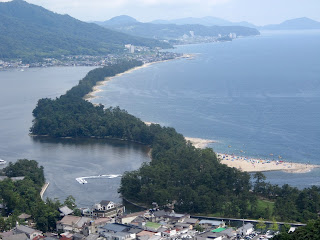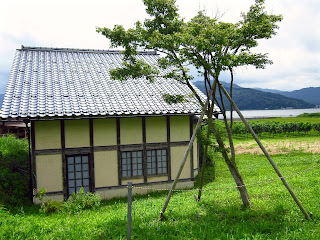A couple of weeks ago I made a weekend trip to Tango with my friends.
We started at Amanohashidate, a 3.3 km long isthmus covered with thousands of pine trees cutting across Miyazu Bay. This "bridge in heaven" (the translation of Amonohashidate) is traditionally, and oddly, viewed upside down (i.e. between your legs). From this vantage point the sandbar appears to be a path climbing into the sky. Amanohashidate is ranked among Japan's three most scenic places (nihon sankei) and was the inspiration for the garden pond at Katsura Imperial Villa.
The eastern coast of the narrow sandbar is dotted with white sand beaches for sunbathing and swimming. I was anxious to take a dip; this was really my main objective. But I was surprised to find the water a tepid 27°C (80°F). It was nonetheless refreshing and enjoyable.
For lunch we went to Amanohashidate Winery (est. 1999). This small vineyard on the north shore of the Asoumi Sea (the enclosed west side of the Amanohashidate sandbar) grows its own grapes and utilizes German production methods. They produce a variety of drinkable if not exactly remarkable wines using mostly Seibel grapes.
From there we drove to Ine along Route 178, which is Japan's, or at least Kansai's PCH (Pacific Coast Highway). It is known by the local surfers as "Surf Highway", though the good surfing is on the opposite side of the Tango Peninsula. It is a delightful two-lane road built just a few meters above the sea that hugs the curves of the coast .
Ine is a small fishing village famous for its funaya (boat houses). Where most houses in Japan have a car in the garage, these waterfront dwellings have boats. The ground floor is literally in the sea.

Our guesthouse, called Tycho, was deep in the Tango countryside and required an old-fashioned phone call when the car GPS failed to find it. It was a quirky renovation of an old building that had only just opened.
After freshening up at a nearby onsen we were treated to a special meal in the guest house prepared by a local chef my friends had befriended on a previous trip. I manned the bar and kept everyone lubricated between courses. The dinner was simple but exquisite.
Hanabi (fireworks) followed. In Japan fireworks can be purchased by anyone at any supermarket all summer long. I found myself trying to explain that fireworks are illegal in the States even though most anyone can buy a gun. Huh?
The next morning we woke early and a local fisherman/sushi chef (?) showed us how to make sushi. Yep, sushi for breakfast. I've had fish for breakfast before, but never sushi. We all donned the colorful happi jackets of a sushi chef and got to work. The ultra fresh fish plus my own touch...yeah, good.
Strange. This was a completely Japanese weekend, a typical summer holiday. There was very little English spoken and scarcely a gaijin to be seen. But somehow it felt very familiar. There was something very California about it all, from the beach to the winery to Surf Highway. Maybe I've found a little California in Japan.







No comments:
Post a Comment